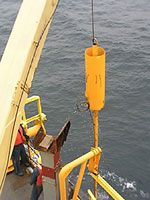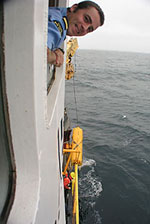

 | |||||||||||||
|
|
Journals 2006/2007Miriam Sutton
August 8, 2006 AM Location: Orphan Basin (54° 15' 57.73" N, 51° 48' 07.49" W) We continued our seismic data collection at Orphan Basin until 10:00AM. The gear was pulled aboard and the ship began steaming toward a section of the Labrador Sea known as Hamilton Spur. The scientists collected another core sample at 2000 meters. The total core length is 50 feet in length. (See Core Sample photo below.)
The section of the Labrador Slope known as Hamilton Spur has a history of rapid changes in sedimentation and this core sample will allow the scientists to assess any recent changes in sedimentation. The core is raised along side the ship and secured in place by the crew. (See Securing Core Sample photo below.)
It is truly a team effort between the scientists and crew to collect this type of data. Watching them work as a cohesive unit throughout the day was amazing. Everyone on board tunes in for the core deployment and collection procedures for a core sample. I even caught the ships' officers enjoying the hands-on science. (See CCGS Officer photo below.)
Today's activity: (Ask mom to bake a cake for this activity. The cake will make a nice medium for this activity and it will be fun to eat during your discussion.) Once the cake has cooled, push a straw down through the every layer of the cake and then carefully remove the core sample you collected. Use the blunt end of a skewer stick (or similar tool) to push the cake core out of the straw. Record your observations and note any differences between your data collection and that of the scientists completing a coring on the seafloor. Discuss your observations over cake and milk. YUM! Word of the Day: Cohesive REMINDER: Record today's Sea Surface Temperature (SST) and the Air Temperature on the data table you created from the August 05 journal entry. |
||||||||||||


